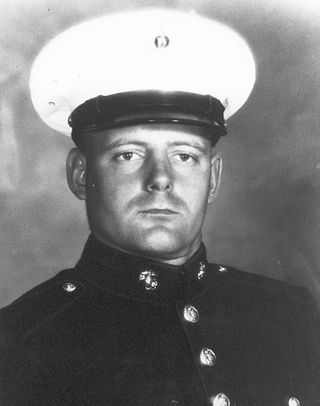
Lapis lazuli, or lapis for short, is a deep-blue metamorphic rock used as a semi-precious stone that has been prized since antiquity for its intense color. Originating from the Persian word lazhuward meaning 'blue', lapis lazuli is a rock composed primarily of the minerals lazurite, pyrite and calcite. As early as the 7th millennium BC, lapis lazuli was mined in the Sar-i Sang mines, in Shortugai, and in other mines in Badakhshan province in modern northeast Afghanistan. Lapis lazuli artifacts, dated to 7570 BC, have been found at Bhirrana, which is the oldest site of Indus Valley civilisation. Lapis was highly valued by the Indus Valley Civilisation. Lapis beads have been found at Neolithic burials in Mehrgarh, the Caucasus, and as far away as Mauritania. It was used in the funeral mask of Tutankhamun.

A non-commissioned officer (NCO) is a military officer who does not hold a commission. Non-commissioned officers usually earn their position of authority by promotion through the enlisted ranks. In contrast, commissioned officers usually enter directly from a military academy, officer training corps (OTC) or reserve officer training corps (ROTC), or officer candidate school (OCS) or officer training school (OTS), after receiving a post-secondary degree.
Corporal is a military rank in use by the armed forces of many countries. It is also a police rank in some police services. The rank is usually the lowest ranking non-commissioned officer. In some militaries, the rank of corporal nominally corresponds to commanding a section or squad of soldiers.
Lance corporal is a military rank, used by many English-speaking armed forces worldwide, and also by some police forces and other uniformed organisations. It is below the rank of corporal.

James Norman Mattis is an American military veteran who served as the 26th United States secretary of defense from 2017 to 2019. A retired Marine Corps four-star general, he commanded forces in the Persian Gulf War, the War in Afghanistan, and the Iraq War.
Budd Root is an American cartoonist, and creator of the independent comic book Cavewoman, published by Root's company Basement Comics / Amryl Entertainment. Root is one of the premiere contemporary "good girl" artists, with an art style similar to Art Adams.'

Jedh Colby Barker was a United States Marine Corps Lance Corporal who posthumously received the Medal of Honor for heroism during the Vietnam War in September 1967.

Emilio Albert De La Garza, Jr. was a United States Marine Corps lance corporal who was posthumously presented the nation's highest military honor — the Medal of Honor — for heroism above and beyond the call of duty on April 11, 1970, in South Vietnam during the Vietnam War.

Lester William Weber was a United States Marine who posthumously received the Medal of Honor for heroism in Vietnam in February 1969.

James Donnie Howe was a United States Marine who posthumously received the Medal of Honor for his heroic actions in May 1970 during the Vietnam War.

José Francisco "Jo Jo" Jiménez was a United States Marine Corps Lance Corporal who posthumously received the Medal of Honor for heroism in the Vietnam War in August 1969.

Miguel Keith was a United States Marine who posthumously received the United States's highest military decoration — the Medal of Honor for heroism in Vietnam in May 1970. Despite being severely wounded, he advanced on enemy attackers, allowing his platoon to rout the attack of a numerically superior enemy force.

Thomas Patrick Noonan Jr. was a United States Marine who was posthumously awarded the United States' highest military decoration — the Medal of Honor — for heroism during February 1969 in Vietnam.

William Raymond Prom was a United States Marine who posthumously received the Medal of Honor for heroism in February 1969 during the Vietnam War.

Military humor is humor based on stereotypes of military life. Military humor portrays a wide range of characters and situations in the armed forces. It comes in a wide array of cultures and tastes, making use of burlesque, cartoons, comic strips, double entendre, exaggeration, jokes, parody, gallows humor, pranks, ridicule and sarcasm.

William Kyle Carpenter is a medically retired United States Marine who received the United States' highest military honor, the Medal of Honor, for his actions in Marjah, Helmand Province, Afghanistan in 2010. Carpenter is the youngest living Medal of Honor recipient.

Duffel Blog is an American military news satire organization featuring satirical articles reporting on national security and US military topics. It is often described as "the military version of The Onion." It was founded in March 2012 by Marine veteran Paul Szoldra, originally as a way to drive web traffic to the now defunct website CollegeVeteran.com.

The crayon-eating Marine is a humorous trope associated with the United States Marine Corps, emerging online in the early 2010s. Playing off of a stereotype of Marines as unintelligent, the trope supposes that they frequently eat crayons and drink glue. In an instance of self-deprecating humor, the crayon-eater trope was popularized by Marines through social media and in Maximilian Uriarte's comic strip Terminal Lance. The joke's ubiquity has led to real-life humorous consumption of crayons and has been referenced by the Marine Corps itself in celebration of National Crayon Day. Multiple products have capitalized on the trend, including two lines of edible crayons created by former Marines and a coloring book by Uriarte.















